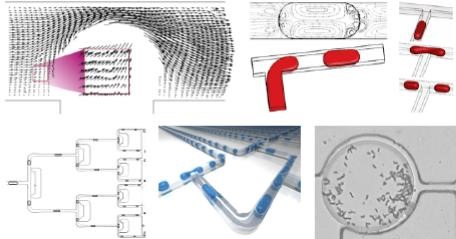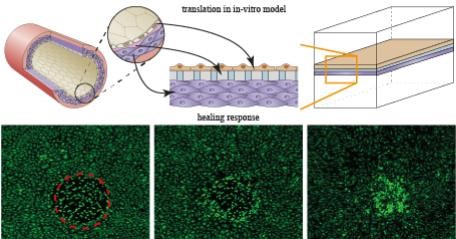Droplet microfluids
Without a deep understanding of the physics of fluids at the microscale, the development of laboratories-on-a-chip will largely be a “trial-and-error” expedition. My group solves (both long-standing and fresh) problems related to the flow of droplets in micro channel systems, both through experiments and numerical methods. We also apply the fundamentals to engineer systems that solve real world problems, for example by developing a platform for high-throughput screening under industrially relevant conditions.

Fundamentals of interfaces
My group is generally interested in the behavior of interfaces, with a special interest in diffuse interfaces. We for example use so-called "aqueous two phase systems", as their interface thickness is typically much larger compared to classical oil-water interfaces. We also use numerical methods (phase field) to study the influence of the interfacial properties on global flow behavior.

In vitro arterial model for cardiovascular research
Cardiovascular diseases are the number 1 cause of death globally; taking 17.5 million lives per year. Nearly 75% of this morbidity is caused by atherosclerosis, i.e. the narrowing of arteries due to the accumulation of lipids inside the arterial wall. In a collaborative effort with researchers of the Erasmus Medical Center, we develop an in vitro model of a coronary artery to study how to improve the safety of atherosclerosis treatment. Besides the experimental work, with microfluidics as the enabling technology, we also model the transport phenomena of lipids, proteins, drugs in the arterial wall. The first results have been presented in a series of conferences, among which the national CardioVasculaireConferentie 2016, the International Organ-on-a-Chip Symposium 2016 and the Organ-on-a-Chip World congress 2016. This work is performed within the Dutch instute for "Human Disease Model Technology".

Diagnositics of early disease detection
In a large research consortium funded by the Dutch Cancer Society (KWF) we deepen the understanding how to perform an early detection of prostate cancer based on exosomes present in urine samples, and apply this knowledge to build a diagnostic tool based on microfluidic technology. For more information, please click here
